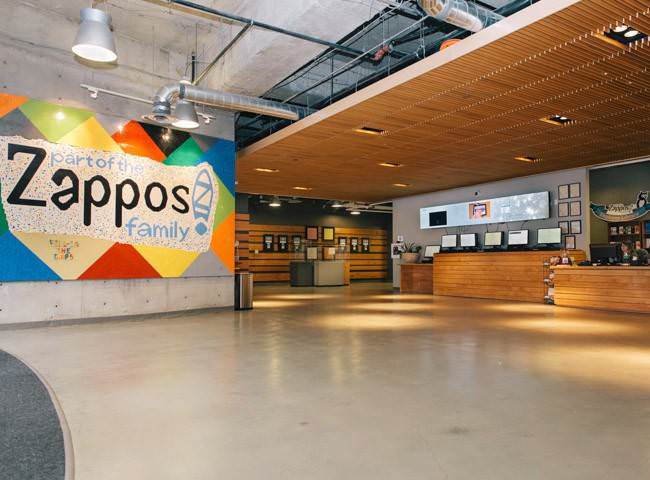Research and consulting firms often tout the creation of a customer-centric culture as the primary vehicle for any organization seeking to compete in a world where the customer is dictating the stakes in the moment, often through increasingly powerful mobile technology. But cultures aren’t created, they evolve with each new hire or touchstone event, and are often resilient to change. Instead of attempting wholesale cultural changes in hopes that your organization will see the light of customer centricity, instead treat your corporate culture as a design constraint to work with. This will increase the chances of success with CX initiatives.
Creating an environment where the people in your organization are thinking customer-first is the long game, one that could take years or even decades. Zappos became one of the most cited examples of having a customer-centric culture because it was baked in from the start:
We asked ourselves what we wanted this company to stand for,” said CEO Tony Hsieh, “we didn’t want to sell just shoes. I wasn’t even into shoes - but I was passionate about customer service.

Chances are, your company is less like Zappos and more like some of the companies we spoke with while attending Consero CX in Pasadena in March. The panel and discussion-focused event covered everything from infusing emotion in call center service and measuring CX to the continued impact of digital on customer interactions with services. Even with technology noted as both an enabler and a hurdle for great customer experiences, the most common thread was the challenges of orchestrating the people and processes that create a cohesive service across various touchpoints. And with that a larger discussion around building a customer-centric culture.
Throughout conversations with executives across industries including manufacturing, media, and hospitality, a consistent theme emerged: the design of customer experience initiatives was a challenge in its own right, but it was the implementation and measurement of these initiatives where the lack of a customer-centric culture emerged.
One executive from a global manufacturer commented “I’m listening to customer service calls right after a week-long training and it’s as if the agents weren’t even at the training in the first place.” Another CX leader from an enterprise media company described her challenge consulting across hundreds of local newspapers and digital properties as “attempting to conduct an orchestra reading off different sheets of music. That’s if they show up to play.” An operations executive from a global hospitality company had a unique challenge. Many of the people who work in the hotel group come from a customer service background. His unique challenge is getting employees to embrace the CX tenets of the brand. In some cases unlearning what on paper were customer-centric behaviors for previous employers.
I’m listening to customer service calls right after a week-long training and it’s as if the agents weren’t even at the training in the first place.
These companies are in some cases just starting their journey to customer centricity. You might have a similar story or cultural makeup. Regardless, you can still understand the cultural constraints you have by exploring the following:
Qualify leadership’s appetite for CX as a strategic imperative.
Understand how “bought-in” your executive team is on being a customer-centric culture. Few have as big an impact on company culture as the CEO and her deputies. If the customer experience isn’t a focus in the annual report or company kickoff, understand where their perspective lies in customer experience as a strategic differentiator. This answer will dictate how much support you’ll get when designing new experiences.
Conduct internal qualitative and quantitative research to uncover areas of weakness.
Whether you’re defining a new script for call center agents or building a voice of the customer program, an assessment of what your people can and can’t bring to the table will be an important factor in the success of those initiatives. Work with HR and leadership to perform a company-wide evaluation to identify employees who exhibit the customer-first values you hope to instill through the organization. Through this process you’ll naturally uncover individuals or groups where the customer is not understood or focused on - a constraint to building an effective customer journey map, for example. Collaborate with HR to find career opportunities for those employees who are customer-centric and use them as ambassadors to recruit others in the company or outside who can help you deliver on CX initiatives.
Develop a deep partnership with human resources to understand and refine hiring practices.
People, especially those on the front line talking with customers, are your most important asset and HR owns that connection in many organizations. They are also potential impediments to your ability to move the company in the direction of customer centricity. Work with HR leadership to understand overall hiring strategy and identify recruiting and interviewing practices that are hurting your company’s ability to find people with a knack for thinking customer-first. If these customer-centric practices aren’t in place you’ll likely need to campaign for change while focusing on leveraging those internal CX champions you discovered with your research.
Talk to your customers.
Easy on paper but tough in practice, depending on your industry and cultural norms. Customers will tell you where the weakest links are in your brand’s experience. Chances are, those weaknesses will not only expose business process areas to explore, but also highlight aspects of how you interact with customers. Your ability to create an ongoing dialogue with customers will highlight a key constraint - whether your company has the means or interest. If this is a struggle, you’ll need to rely on the systems you have in place that capture customer interactions such as contact form logs, CRM and social media data to name a few. You’ll also need to perform more internal research with those roles that have a direct line to the customer such as sales and executives.
Design is all about constraints. These constraints dictate need and force experimentation and creativity, which lead to innovation. By not treating culture as a constraint to work around, you’ll wind up designing a series of initiatives that will struggle to achieve outcomes. Don’t let that happen. Take stock in what your company is capable of now to get quick wins while you build on your long-term strategy putting the customer at the center of your business.



